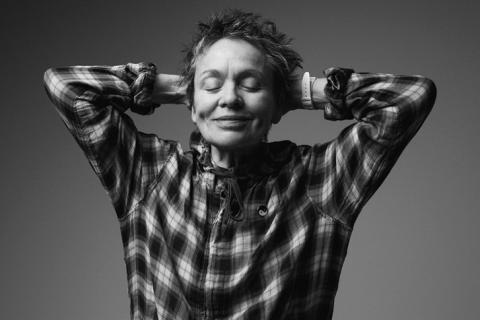Laurie Anderson Doesn't Define Herself and Neither Should You

Image by Ebru Yildiz
Trying to describe the kind of artist that Laurie Anderson is can be a bit like trying to sum up what the ocean is. It’s water, for sure, just like Anderson is for sure an artist. But then, there's what the ocean looks like on the surface versus what it’s like underneath. How deep do we go, though? Are we talking watching crabs in ankle-deep tide pools or the untold organisms living impossibly in the depths of the midnight zone? Where do you start? Musician, composer, performance artist, director, virtual reality (VR) experience designer—these descriptors get close to the kind of work the Grammy-winner has achieved over the last half-century, but it’s far from a sufficient definition.
Berklee students got the chance to hear from Anderson directly in a recent visiting artist interview, conducted remotely and moderated by Nona Hendryx, ambassador for artistry in education, and sponsored by the Electronic Production and Design (EPD) Department. Calling the session a Q&A is a bit misleading, as Anderson has a way of playfully eschewing direct answers in favor of offering an answer to an unasked question, or even answering in the form of a new question.
“It’s good to not define yourself too tightly. It’s okay to be loose. And then you can do anything."
—Laurie Anderson
For instance, knowing that Anderson first came to music through the violin, Hendryx asked if being a violinist was Anderson’s first career dream as a child. After a long pause, Anderson responded by asking Hendryx, “Do you remember your dreams?”
The mention of dreams was an apt one, given that Anderson will serve as the 2021 virtual visiting artist for the EPD Department, primarily to help students continue to develop the Dream Machine, a virtual-performance experience set inside a custom-built video game.
Anderson did arrive at a sort-of answer to Hendryx’s question, flipping it into a piece of advice for the students in attendance, saying, “It’s good to not define yourself too tightly. It’s okay to be loose. And then you can do anything. You don’t have to think ‘Is that going to feed into my style?’”
Watch a guided tour by Laurie Anderson about Chalkroom, one of her recent VR exhibitions:
Even her interest in violin music is about discovery, as she admitted that she’s always preferred an orchestra’s second violin parts over the more recognizable first violin parts. “There are so many hidden masterpieces in other things,” she said. And to bring back the ocean analogy, Anderson once staged a performance of Claude Debussy’s La Mer (or The Sea) with only the second violin parts, describing the result as the sound of waves undulating. “As a minimalist, I sometimes prefer the simpler, more repetitive parts that are holding the whole thing together,” she said.
To listen to Anderson talk, then, is a lot like interacting with one of her multifaceted projects, particularly the deeply layered worlds she’s created in VR environments. The more you hang around and pay attention, the more wisdom seems to accumulate. Toward the end of the conversation, Anderson was asked whether art created for environments such as Zoom was a promising frontier beyond the pandemic’s constraints, and true to fashion, her answer pointed to something deeper about art and innovation. When the art is good, she said, “It stops mattering whether it’s in a little window box [on your computer] or not. You go into this other world, whether it’s music or a play or a reading or a conversation—there are many things that work very well this way. It’s really nice to have a whole other viable way to do things.”